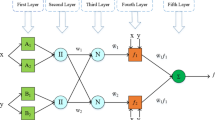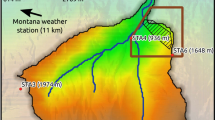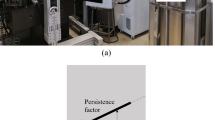Abstract—Granular media determine the dynamics of many natural systems including faults in the Earth’s crust. The paper addresses the laboratory study of shear deformation of a model fault simulated by a layer of granular material located between rock blocks. A model fault is a complex dynamic system characterized by the presence of bifurcations and fast and slow slips may take turn aperiodically during deformation. The sliding of the rock blocks is accompanied by the generation of acoustic emission pulses (AEs) which are identified based on the Akaike information criterion. The dynamics of AEs reflects the evolution of mechanical properties of the fault. In the flow of AEs, the subsets with different rise time/amplitude values (RA-values) and different scaling relations are identified. Applying the random forest machine learning algorithm to the analysis of AE catalogue demonstrates the possibility of determining the velocity of fault sliding and the time to both fast and slow slips. The nucleation of a certain slip mode is predetermined by the self-organization processes taking place in the central zone of a fault, and the characteristics of the AE reflect these processes. The proposed approach to the estimation of fault sliding parameters can be promising for the design of new methods for monitoring stressed massifs at mining.










Similar content being viewed by others
REFERENCES
Bergen, K.J., Johnson, P.A., de Hoop, M.V., and Beroza, G.C., Machine learning for data-driven discovery in solid Earth geoscience, Science, 2019, vol. 363, no. 6433, Article ID eaau0323. https://doi.org/10.1126/science.aau0323
Bolton, D.C., Shreedharan, S., Rivière, J., and Marone, C., Acoustic energy release during the laboratory seismic cycle: Insights on laboratory earthquake precursors and prediction, J. Geophys. Res.: Solid Earth, 2020, vol. 125, no. 8, Article ID e2019JB018975. https://doi.org/10.1029/2019JB018975
Brace, W.F. and Byerlee, J.D., Stick-slip as a mechanism for earthquakes, Science, 1966, vol. 153, no. 3739, pp. 990–992.
Breiman, L., Random forests, Machine Learning, 2001, vol. 45, pp. 5–32. https://doi.org/10.1023/A:1010933404324
Burgmann, R., The geophysics, geology and mechanics of slow fault slip, Earth Planet. Sci. Lett., 2018, vol. 495, pp. 112–134. https://doi.org/10.1016/j.epsl.2018.04.062
Carpinteri, A., Xu, J., Lacidogna, G., and Manuello, A., Reliable onset time determination and source location of acoustic emissions in concrete structures, Cem. Concr. Compos., 2012, vol. 34, no. 4, pp. 529–537.
Damaskinskaya, E.E., Panteleev, I.A., Gafurova, D.R., and Frolov, D.I., Structure of a deformed inhomogeneous material on the data of acoustic emission and X-ray computer microtomography, Phys. Solid State, 2018, vol. 60, no. 7, pp. 1363–1367.
de Arcangelis, L., Godano, C., Grasso, J.R., and Lippiello, E., Statistical physics approach to earthquake occurrence and forecasting, Phys. Rep., 2016, vol. 628, pp. 1–91. https://doi.org/10.1016/j.physrep.2016.03.002
Frank, W., Shapiro, N.M., Husker, A., et al., The evolving interaction of low-frequency earthquakes during transient slip, Sci. Adv., 2016, vol. 2, no. 4, Article ID e1501616. https://doi.org/10.1126/sciadv.1501616
Gao, K., Guyer, R., Rougier, E., et al., From stress chains to acoustic emission, Phys. Rev. Lett., 2019, vol. 123, PaperID 048003. https://doi.org/10.1103/PhysRevLett.123.048003
Goebel, T.H.W., Schorlemmer, D., Becker, T.W., et al., Acoustic emissions document stress changes over many seismic cycles in stick-slip experiments, Geophys. Res. Lett., 2013, vol. 40, pp. 2049–2054. https://doi.org/10.1002/grl.50507
Hadda, N., Nicot, F., Wan, R., and Darve, F., Microstructural self-organization in granular materials during failure, C. R. Mec., 2015, vol. 343, no. 2, pp. 143–154. https://doi.org/10.1016/j.crme.2014.09.009
Hayman, N.W., Ducloué, L., Foco, K.L., et al., Granular controls on periodicity of stick-slip events: kinematics and force-chains in an experimental fault, Pure Appl. Geophys., 2011, vol. 168, Paper ID 2239. https://doi.org/10.1007/s00024-011-0269-3
Kocharyan, G.G., Geomekhanika razlomov (Geomechanics of Faults), Moscow: GEOS, 2016.
Kocharyan, G.G. and Kishkina, S.B., The physical mesomechanics of the earthquake source, Phys. Mesomech., 2021, vol. 24, pp. 343–356.
Kocharyan, G.G. and Ostapchuk, A.A., Variations in rupture zone stiffness during a seismic cycle, Dokl. Earth Sci., 2011, vol. 441, no. 1, pp. 1591–1594.
Kocharyan, G.G., Kishkina, S.B., Novikov, V.A., and Ostapchuk, A.A., Slow slip events: parameters, conditions of occurrence, and future research prospects, Geodinam. Tektonofiz., 2014, vol. 5, no. 4, pp. 863–891. https://doi.org/10.5800/GT-2014-5-4-0160
Kocharyan, G.G., Ostapchuk, A.A., and Pavlov, D.V., Traces of laboratory earthquake nucleation in the spectrum of ambient noise, Sci. Rep., 2018a, vol. 8, Article ID 10764. https://doi.org/10.1038/s41598-018-28976-9
Kocharyan, G.G., Ostapchuk, A.A., Pavlov, D.V., and Markov, V.K., The effects of weak dynamic pulses on the slip dynamics of a laboratory fault, Bull. Seismol. Soc. Am., 2018b, vol. 108, no. 5B, pp. 2983–2992. https://doi.org/10.1785/0120170363
Kocharyan, G.G., Ostapchuk, A.A., and Pavlov, D.V., Fault sliding modes—governing, evolution and transformation, in Multiscale Biomechanics and Tribology of Inorganic and Organic Systems, Ostermeyer, G.-P., Popov, V.L., Shilko, E.V., and Vasiljeva, O.S., Eds., Springer Tracts in Mechanical Engineering Ser., Cham: Springer, 2021, pp. 323–358. https://doi.org/10.1007/978-3-030-60124-9_15
Leeman, J., Saffer, D., Scuderi, M., et al., Laboratory observations of slow earthquakes and the spectrum of tectonic fault slip modes, Nat. Commun., 2016, vol. 7, Article ID 11104. https://doi.org/10.1038/ncomms11104
Lei, X., How does asperities fracture? An experimental study of unbroken asperities, Earth Planet. Sci. Lett., 2003, vol. 213, no. 3, pp. 347–359. https://doi.org/10.1016/S0012-821X(03)00328-5
Lherminier, S., Planet, R., Levy dit Vehel, V., et al. Continuously sheared granular matter reproduces in detail seismicity laws, Phys. Rev. Lett., 2019, vol. 122, Article ID 218501. https://doi.org/10.1103/PhysRevLett.122.218501
Maeda, N., A method for reading and checking phase times in autoprocessing system of seismic wave data, J. Seismol. Soc. Jpn., 1985, vol. 38, no. 3, pp. 365–379.
Marone, C., Laboratory-derived friction laws and their application to seismic faulting, Annu. Rev. Earth Planet. Sci., 1998, vol. 26, pp. 643–696. https://doi.org/10.1146/annurev.earth.26.1.643
Michlmayr, G. and Or, D., Mechanisms for acoustic emissions generation during granular shearing, Granular Matter, 2014, vol. 16, pp. 627–640. https://doi.org/10.1007/s10035-014-0516-2
Ostapchuk, A.A., and Morozova, K.G., On the mechanism of laboratory earthquake nucleation highlighted by acoustic emission, Sci. Rep., 2020, vol. 10, Article ID 7245. https://doi.org/10.1038/s41598-020-64272-1
Ostapchuk, A.A., Pavlov, D.V., Markov, V.K., and Krasheninnikov, A.V., Study of acoustic emission signals during fracture shear deformation, Acoust. Phys., 2016, vol. 62, no. 4, pp. 505–513.
Ostapchuk, A.A., Pavlov, D.V., Ruzhich, V.V., et al. Seismic-acoustics of a block sliding along a fault, Pure Appl. Geophys., 2020, vol. 117, pp. 2641–2651. https://doi.org/10.1007/s00024-019-02375-1
Panteleev, I.A., Analysis of the seismic moment tensor of acoustic emission: granite fracture micromechanisms during three-point bending, Acoust. Phys., 2020, vol. 66, no. 6, pp. 653–665.
Ren, C.X., Hulbert, C., Johnson, P.A., and Rouet-Leduc, B., Machine learning and fault rupture: a review, Adv. Geophys., 2020, vol. 61, pp. 57–107. https://doi.org/10.1016/bs.agph.2020.08.003
Rodkin, M.V., A typical foreshock and aftershock anomaly: observations, interpretation, and applications, J. Volcanol. Seismol., 2020, vol. 14, no. 1, pp. 58–70.
Rodkin, M.V. and Rundkvist, D.V., Geoflyuidogeodinamika. Prilozhenie k seismologii, tektonike, protsessam rudo- i neftegeneza (Geofluid Geodynamics: Application to Seismology, Tectonics, Ore and Oil Formation Processes), Dolgoprudnyi: Intellekt, 2017.
Sammis, C., King, G., and Biegel, R., The kinematics of gouge deformation, Pure Appl. Geophys., 1987, vol. 125, no. 5, pp. 777–812.
Scholz, C.H., The Mechanics of Earthquakes and Faulting, Cambridge: Cambridge Univ. Press, 2002.
Shiotani, T., Ohtsu, M., and Ikeda, K., Detection and evaluation of AE waves due to rock deformation, Constr. Build. Mater., 2001, vol. 15, no. 5–6. pp. 235–246. https://doi.org/10.1016/S0950-0618(00)00073-8
Sleeman, R. and van Eck, T., Robust automatic P-phase picking: an on-line implementation in the analysis of broadband seismogram recordings, Phys. Earth Planet. Inter., 1999, vol. 113, nos. 1–4, pp. 265–275.
Smirnov, V.B. and Ponomarev, A.V., Seismic regime relaxation properties from in situ and laboratory data, Izv. Phys. Solid Earth, 2004, vol. 40, no. 10, pp. 807–816.
Smirnov, V.B., Ponomarev, A.V., Stanchits, S.A., et al., Laboratory modeling of aftershock sequences: stress dependences of the Omori and Gutenberg–Richter parameters, Izv. Phys. Solid Earth, 2019, vol. 55, no. 1, pp. 124–137. https://doi.org/10.1134/S1069351319010105
Sobolev, G.A., Seismicity dynamics and earthquake predictability, Nat. Hazards Earth Syst. Sci., 2011, vol. 11, pp. 445–458. https://doi.org/10.5194/nhess-11-445-2011
Sobolev, G.A. and Ponomarev, A.V., Acoustic emission and fracture stages in a laboratory experiment, Vulkanol. Seismol., 1999, nos. 4–5, pp. 50–62.
Sobolev, G.A. and Ponomarev, A.V., Fizika zemletryasenii i predvestniki (Physics of Earthquakes and Precursors), Moscow: Nauka, 2003.
Townend, J. and Zoback, M.D., How faulting keeps the crust strong, Geology, 2000, vol. 28, no. 5, pp. 399–402.
Turcotte, D.L., Self-organized criticality, Rep. Prog. Phys., 1999, vol. 62, pp. 1377–1429. https://doi.org/10.1088/0034-4885/62/10/201
Veedu, D.M., Giorgetti, C., Scuderi, M., et al., Bifurcations at the stability transition of earthquake faulting, Geophys. Res. Lett., 2020, vol. 47, no. 19, Article ID e2020GL087985. https://doi.org/10.1029/2020GL087985
Vettegren, V.I., Shcherbakov, I.P., Mamalimov, R.I., Sobolev, G.A., and Ponomarev, A.V., Nanosecond dynamics of destruction of the surface layer of a heterogeneous nanocrystalline solid (sandstone) under the friction, Phys. Solid State, 2017, vol. 59, no. 5, pp. 955–959.
Wyss, M. and Habermann, R.E., Precursory seismic quiescence, Pure Appl. Geophys., 1988, vol. 126, pp. 319–332. https://doi.org/10.1007/BF00879001
Funding
The experiments were designed and conducted in partial fulfillment of the State contract with the Ministry of Science and Higher Education of the Russian Federation (project no. AAAA-A17-117 112350020-9 (D.V.P., G.A.G., K.G.M)) and supported by the Russian Foundation for Basic Research (project no. 20-55-53031 (G.G.K., D.V.P.)). The concept design of AE data analysis and its software implementation were supported by the Russian Science Foundation under project no. 20-77-10087 (A.A.O., K.G.M.).
Author information
Authors and Affiliations
Corresponding author
Additional information
Translated by M. Nazarenko
Rights and permissions
About this article
Cite this article
Ostapchuk, A.A., Kocharyan, G.G., Morozova, K.G. et al. Peculiarities of Dynamic Slip Nucleation in a Thin Granular Layer. Izv., Phys. Solid Earth 57, 659–670 (2021). https://doi.org/10.1134/S106935132105013X
Received:
Revised:
Accepted:
Published:
Issue Date:
DOI: https://doi.org/10.1134/S106935132105013X




